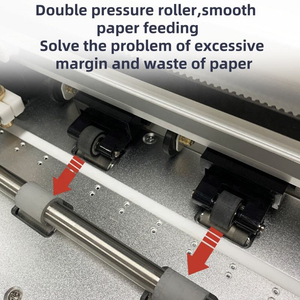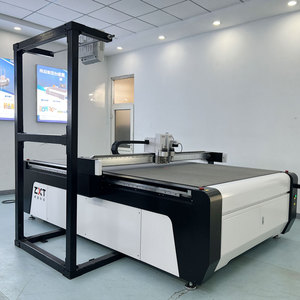
All categories
Featured selections
Trade Assurance
Buyer Central
Help Center
Get the app
Become a supplier

(4824 products available)




















Market Overview: The rubber die cutting machine market is poised for notable growth, reflecting broader trends within the rubber and plastics industry. In 2024, the rubber and plastics market in Germany alone is projected to reach a value added of approximately US$38.1 billion, with an output nearing US$99.8 billion, according to Statista. This robust performance is indicative of the increasing demand for specialized machinery, including rubber die cutting machines, which are essential for precision manufacturing in various sectors. Furthermore, the global market for tire curing presses, a related segment, is expected to grow from $1.16 billion in 2023 to $1.22 billion in 2024, showcasing a compound annual growth rate (CAGR) of 5.1%. This growth can be attributed to the rising demand for durable tires and advancements in tire manufacturing technologies.
Industry Insights: The demand for rubber die cutting machines is driven by the automotive and manufacturing sectors, which are increasingly adopting automation and precision cutting technologies. As reported by Global Industry Analysts, the market for laser cutting machines, which often overlaps with die cutting applications, is projected to grow from US$35.4 billion in 2023 to US$49.3 billion by 2030, reflecting a CAGR of 4.9%. This trend indicates a broader shift towards more efficient production processes. Additionally, the Asia-Pacific region has emerged as a significant player in this market, driven by rapid industrialization and increased manufacturing capabilities. Consumer preferences are also shifting towards customized and high-quality products, further fueling the demand for rubber die cutting machines that offer versatility and efficiency in production.
Manual rubber die cutting machines are hand-operated. The user must apply pressure to cut rubber into specific shapes or designs. They work slowly and need a lot of attention. Some prefer this machine because it provides precise cuts. They are also affordable and do not need power. But, it takes longer and is hard to do large projects.
The hydraulic die cutting machine uses liquid pressure to cut rubber. The liquid pressure comes from a pump or a machine that drives the process. These machines cut quickly and handle tough jobs. They can also cut thick materials. The big downside is they are expensive and need a professional to run. The machines are loud and take up a lot of space.
An electric die cutting machine cuts rubber using electricity. An electric motor applies pressure to the die. The machines cut faster than manual or hydraulic machines. They are easy to use and work well for large projects. But they are more costly and need repairs sometimes.
A rotary die cutting machine cuts by moving a die and rubber material in a circle. This method allows for fast cutting with less waste. It works well for continuous production of gaskets, seals, and o-rings. There are two types of rotary die cutters. They include.
The auto industry uses rubber die cutters to make seals, gaskets, and mats. This machines helps cut parts quickly and accurately. It reduces the time it takes to make large orders. The machines also ensures that all parts are the same size, which improves quality. With so many cuts done fast, waste goes down too. This saves money and helps the environment.
The medical industry relies on these machines to cut rubber for medical devices. The machines provide precise cuts that meet strict safety rules. They help produce parts like seals, tubes, and gloves.
Using die cutters improves production speed and lowers costs. Fewer mistakes in cutting mean better tools for doctors and patients. The machines also cut many parts at once, which saves time.
The electronics industry uses the machines to cut rubber for insulation and protection. The machines cut materials faster, which helps meet large demands. They also cut multiple layers at the same time. This reduces waste from errors in cutting.
By making parts quickly, companies can lower costs and keep prices down for customers. The machines also help create unique shapes that fit different electronic devices.
This industry uses rubber die cutting machines to make packaging materials. The machines cut rubber quickly, helping to fill large orders fast. They cut labels, seals, and spacers with ease. It results in crisp cuts every time, improving the looks of packages.
The machines minimize waste by ensuring each cut is exact. This saves both resources and costs. Moreover, by allowing custom dies, the machines create unique shapes that make packaging more protective and appealing.
Properly installing and using a rubber sheet cutting machine helps the user achieve the desired results. It also enhances the machine's performance and longevity.
The machine's quality impacts the cut's precision and the materials it handles. To ensure quality, one should look at the machine's parts and its ability to maintain consistent pressure while cutting. This helps achieve exact shapes without errors.
One should consider the machine's bed size. Machines with larger beds easily allow for larger layouts or multiple smaller pieces at once. This is ideal for high-volume production.
The machine's materials also affect its durability. Steel machines tend to last longer and withstand heavy use, compared to those made from weaker metals or plastic.
One should ensure that there are certified machine parts. This guarantees consistency in performance. Always select machines from trusted brands that meet industry standards.
Some machines use electricity or hydraulics. These machines are more expensive than manual machines. Large industrial machines also cost more than smaller models. High-capacity machines are priced higher, due to their advanced technology.
Always clean the machine after use. A buildup of rubber debris harms the machine's parts. Secondly, lubricating moving parts prevents wear and tear. This helps the machines run smoothly. As stated above, worn-out parts reduce performance and close up cutting pathways.
The average lead time for these machines is 45 days. But, it can take longer depending on the orders. If the order has custom machines, the wait time may increase. It can also take longer if the manufacturer is facing supply chain problems.
3D printing machines are on the rise. All one needs to do is create a digital model of the desired cut. This also saves time and materials. Users do not need to create physical dies, making it cheaper. Software allows for designing and editing templates quickly, giving more control over the process.
Avoid machines with a high chance of overheating, especially when working for long hours. Do not use machines with low-quality blades. Poor blades could cause ragged cuts. Also avoid machines that produce either too much or too little noise. Machines that are either too loud or too quiet are normally low quality.